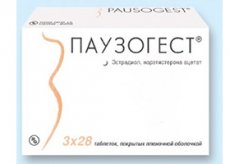Medical expert of the article
New publications
Preparations
Pausogest
Last reviewed: 04.07.2025

All iLive content is medically reviewed or fact checked to ensure as much factual accuracy as possible.
We have strict sourcing guidelines and only link to reputable media sites, academic research institutions and, whenever possible, medically peer reviewed studies. Note that the numbers in parentheses ([1], [2], etc.) are clickable links to these studies.
If you feel that any of our content is inaccurate, out-of-date, or otherwise questionable, please select it and press Ctrl + Enter.

Pauzogest is a monophasic medication used in HRT. The medication includes a complex of the following elements - progestogen with estrogen. Due to the action of the drug, the deficiency of female sex hormones that develops during postmenopause is replenished. The drug contains such components as norethisterone acetate and 17b-estradiol; it must be taken without interruption.
In low doses, progestogen causes and maintains endometrial atrophy. No menstruation occurs during the use of the drug.
Indications Pausogesta
It is used in case of estrogen deficiency syndrome during menopause.
The drug is used to prevent common metabolic disorders, including osteoporosis, which develops in postmenopause if there is a high risk of bone fracture (for example, in the case of low weight, early menopause, calcium deficiency, a family history of severe osteoporosis, as well as smoking or alcoholism, severe movement disorders and taking GCS).
In addition to osteoporosis, the medication is prescribed to prevent other general metabolic disorders that occur during postmenopause (including changes affecting the mucous membranes and epidermis, skin atrophy, cosmetic disorders, etc.).
Release form
The medicinal component is released in tablets - 28 pieces inside a cell plate. In a pack - 1 or 3 plates.
Pharmacodynamics
Estradiol exerts a therapeutic effect through specific estrogen endings. The steroid-receptor structure is synthesized with cellular DNA, and then induces the binding of specific proteins. The substance also affects metabolic processes - for example, it reduces LDL cholesterol levels, and in addition increases triglyceride and HDL cholesterol levels in the blood serum.
Norethisterone acetate is a progestogen that also acts via the endings. It affects the reproductive activity of the female body (this includes changes in the structure of the endometrium). This component affects the processes of lipid metabolism.
The use of a combination of the above components leads to a decrease in LDL and cholesterol values, while serum triglyceride and HDL values remain the same.
Pharmacokinetics
Microcrystalline estradiol is absorbed well and at a high rate. Plasma Cmax values are noted after 4-6 hours from the moment of application, amounting to 90-100 pg/ml. At the same time, the equilibrium plasma level is 70-100 pg/ml.
The half-life is approximately 14-16 hours. More than 90% of the substance is involved in intraplasmic protein synthesis. First, estradiol is oxidized to form estrone, and then transformed into estriol. These processes occur inside the liver.
Estradiol with its metabolic components is excreted mainly by the kidneys (90-95%), and also in the form of a glucuronide or sulfate conjugate that does not have bioactivity. The remainder (about 5-10%) is excreted unchanged in the feces.
Norethisterone acetate is also absorbed at high speed and transformed into the element norethisterone, after which it undergoes metabolic processes and is excreted as sulfate and glucuronide conjugates. The half-life is about 3-6 hours.
Dosing and administration
The medication should be used continuously - usually 1 tablet per day. Such treatment should be prescribed at least after 1 year from the onset of menopause.
 [ 2 ]
[ 2 ]
Use Pausogesta during pregnancy
Pregnant women (or if there is a suspicion that pregnancy has occurred), and also during breastfeeding, should not be prescribed Pauzogest.
Contraindications
Among the contraindications:
- diagnosed malignant neoplasm in the mammary glands, its presence in the anamnesis or suspicion of it;
- diagnosed neoplasm of the estrogen-dependent type (for example, endometrial cancer) or suspicion of its presence;
- chronic or acute phases of liver diseases or a history of pathology after which liver function values did not return to normal;
- enzymopathic jaundice or Rotor syndrome;
- previously suffered or currently in the acute phase of DVT of the legs, as well as thromboembolic pathologies;
- bleeding from the genitals of unknown origin;
- severe stages of diseases in the cardiovascular system or cerebrovascular nature;
- severe intolerance to any component of the drug;
- porphyria or hemoglobinopathies.
Side effects Pausogesta
During the first months of use, short-term spotting or breakthrough bleeding may occur, and in addition, breast sensitivity may temporarily increase. Nausea, headaches, and swelling may occur more rarely.
The use of a progestogen with an estrogen occasionally causes dizziness, migraines, alopecia, epidermal manifestations (for example, chloasma, which may remain after stopping taking the drug) and problems with the use of contact lenses.
 [ 1 ]
[ 1 ]
Overdose
Intoxication can lead to vomiting and nausea.
The medication has no antidote; symptomatic measures are taken.
Interactions with other drugs
Combined use with liver enzyme inducers leads to potentiation of estrogen metabolism processes and weakening of the therapeutic effectiveness of Pauzogest.
The development of drug interactions has been identified when combining drugs with phenytoin, carbamazepine, and also with rifampicin and barbiturates.
Storage conditions
Pauzogest must be stored at temperatures in the range of 15-30°C.
Shelf life
Pauzogest can be used for a period of 36 months from the date of sale of the drug.
Analogues
The analogs of the drug are the substances Evian and Kliogest with Triaclim.
Attention!
To simplify the perception of information, this instruction for use of the drug "Pausogest" translated and presented in a special form on the basis of the official instructions for medical use of the drug. Before use read the annotation that came directly to medicines.
Description provided for informational purposes and is not a guide to self-healing. The need for this drug, the purpose of the treatment regimen, methods and dose of the drug is determined solely by the attending physician. Self-medication is dangerous for your health.

